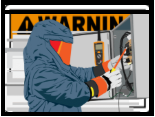OSHA’s 29 CFR 1910.132(d)(1) requires that employers identify and protect their workers from these workplace hazards by performing an assessment that determines the hazards present and also determines the level or personal protective equipment (PPE) requires to mitigate associated workplace hazards.
This is the purpose of an arc-flash study of a facility’s electrical power systems. The result of an arc-flash study will determine the potential energy hazard levels that could be encountered and provide labels (that are installed on the electrical gear) that disclose the required personal protective equipment (PPE) required to safely work on or around energized electrical equipment.
Goals

Reduce Risk

Improve Safety

Verify Compliance
When properly completed, an arc-flash study meets the requirements of:
NFPA 70E , Section 110.1 Standard for Electrical Safety in the Workplace
NFPA 70E, Section 130.5 Arc Flash Analysis
NFPA 70E, Section 130.5 (H) Labeling
NFPA 70E, Section 110.3 (A) Host Employer Responsibilities
OSHA’s 29 CFR 1910.132(d)(1)
Continued..
It is impossible to know the levels of arc flash hazards that are existing in your electrical power system without completing an assessment by knowledgeable technical resources. Therefore, an arc flash assessment must be completed, and the equipment appropriately labeled for the safety of your employees or contract employees working on or operating your electrical equipment.
HECO Engineers has developed a three phased approach to arc flash studies designed not to blow your budget. Our experts use the latest software (SKM) to achieve compliance without excessive data and reports. We will collaborate with your staff to customize an approach that allows you to control the costs of services you need without paying for those that you don’t need. We can offer full arc flash study services or we can provide support your site team, local electrical contractor or engineering firm with any services they need.
You decide.
Phase 1
- Accurate, up-to-date information on the facility electrical system
- Transformer data – KVA, voltages, impedance and nameplate data
- Conductor types
- Fuse and circuit breaker data
- Electric utility – available capacity (minimum & maximum) and available fault current
Phase 2
- Develop accurate Electrical one-line diagrams
- Assessment of existing electrical gear condition and identification of problem areas
- Make recommendations to reduce the amount of potentially hazardous situations in equipment in a facility
- Short-circuit analysis
- Protective device coordination analysis
- Interrupting rating analysis
- Incident Energy Analysis
- Recommend solutions to problems and identify opportunities for improvement
Phase 3
- Generate Arc Flash labels (which include appropriate Personal Protective Equipment (PPE) to be worn by personnel) and adhere them to electrical equipment (per NFPA 7OE).
- Consult on identified Arc Flash hazards and recommend removal (where possible)
- Develop a Written Electrical Safety Program
- Implementing Energized work permits (if not already being utilized)
- Identify Personal Protective Equipment (PPE) required in facility and assist management with information needed to order
- Training on proper wearing of Personal Protective Equipment (PPE)
- Training of Qualified Personnel (Maintenance)
- Training of Unqualified Personnel (Operations)




